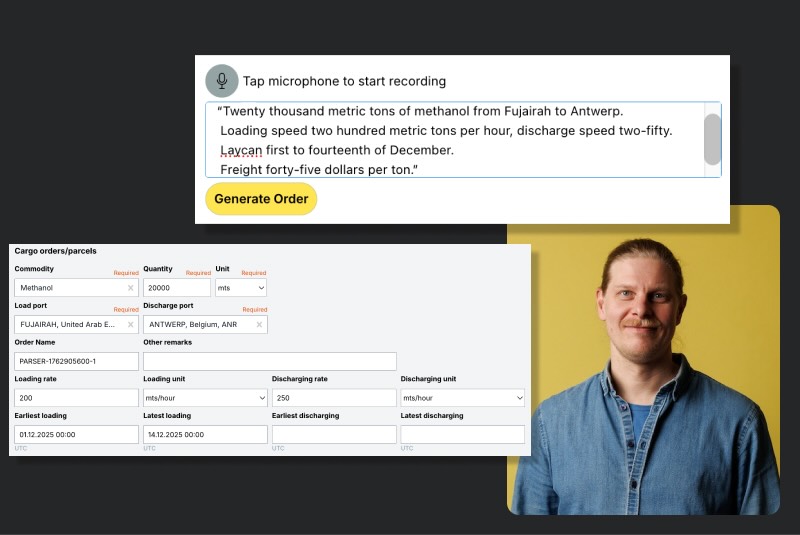Supercharging maritime freight









.webp)






Optimize the utilization of any bulker or tanker fleet
Whether you are a commercial shipowner, an industrial charterer, or a commodity trader, Seaber’s predictive AI platform provides data-driven decision support for scheduling and chartering optimization.
Not only does Seaber deliver the insights that unlock significantly increased fleet utilization and maximize your earnings, it also reduces the environmental impact of shipping.
In addition to single-cargo voyages, the power of Seaber also supports multi-parcel and multi-port voyages, where scheduling is most challenging.
Quickly deployed, with the support of our team through the onboarding process, Seaber integrates seamlessly with existing voyage management systems and ERPs.


How we’re using LLMs to bring structure, speed, and insight to maritime data
At Seaber, we believe the most impactful uses of Large Language Models (LLMs) right now are not magic “agents” running the business; they’re tools that help people work faster and make better decisions by solving long-standing data problems.

How the Seaber platform can improve your scheduling and chartering process
Real-time scheduling

Market knowledge


Operational efficiency
Smart scenarios

Data automation
Reduce emissions
Pro-active
Harnessing the power of Seaber adds up to better deals, quicker decision-making, higher earnings, reduced fuel costs, improved and secure communications, better compliance, and a lower environmental footprint.
Automatic data retrieval, calculations, and visualization
Cargoes and freights • Market cargoes • Port stay durations • Port costs • ETA/ETB/ETD updates • Master data • Routes and leg durations • Bunker consumption • Cargo/vessel requirement check

Seaber solution for:
Commercial shipowners
We serve any dry or wet bulk shipowner as well as breakbulk and heavy lift segments. The Seaber software can retrieve data from any VMS through integration and be quickly deployed to supercharge chartering and scheduling teams with optimization capabilities.
Industrial charterers
We serve industrial charterers with any combination of TC vessels, COA, or spot voyages. Seaber integrates with ERPs to get the cargoes in real-time and/or any VMS to get technical fleet data.
Commodity traders
We help freight traders with market cargo decisions and provide an instant look into a trader’s cashbook. With Seaber traders can create multiple scenarios and compare them for the best outcome.
Client testimonials
Don’t just take our word for it. More and more leading shipowners, charterers, and commodity traders are deploying the Seaber platform to supercharge their freight planning.
Frequently asked questions
Questions? Glad you asked.
Bulk shipping refers to the transportation of large volumes of raw materials and goods, either dry or liquid, by sea, using specialized vessels such as tankers and bulk carriers (i.e. non-containerized).
Over 90% of global trade moves by sea, and bulk shipping is the backbone for commodities like grains, coal, crude oil, and chemicals, making it the most cost-effective and environmentally friendly large-scale transport method. Bulk shipping accounts for over 80% of the world’s tonnage.
TCE is a key commercial metric for understanding a vessel’s average daily earnings. Optimizing TCE directly improves profitability and competitiveness for shipowners and charterers.
High asset utilization means vessels and fleets are used efficiently, minimizing empty voyages and idle time, which boosts profitability and reduces emissions.
Schedule optimization is the process of using advanced planning tools, like predictive AI, to optimize cargo planning and fleet deployment, ensuring cargoes are moved with maximum efficiency and profitability. Commercial shipowners, industrial charterers, commodity traders, and logistics teams benefit from faster planning, reduced costs, and improved fleet utilization.
Historically, scheduling has been manual and spreadsheet-based, which is slow and error-prone, lacking the agility to quickly adapt to market changes or disruptions.
Some companies, through lack of viable alternative options, have chosen to undertake fleet planning in the VMS (Voyage Management System). The two main challenges here are; 1. VMS products are not intended to be used for advanced pre-fixture planning, so lack the capabilities and functionality required and 2. changes made in the VMS have a knock-on effect in the workflow and impact the voyage P&L. Users are reluctant to make too many changes or evaluate scenarios that could impact the P&L, so they choose not to rock the boat and miss out on optimization opportunities.
We are hiring
Our distributed team is growing rapidly, and we are constantly looking for new talent to join us to drive the digital transformation of maritime freight operations.






























